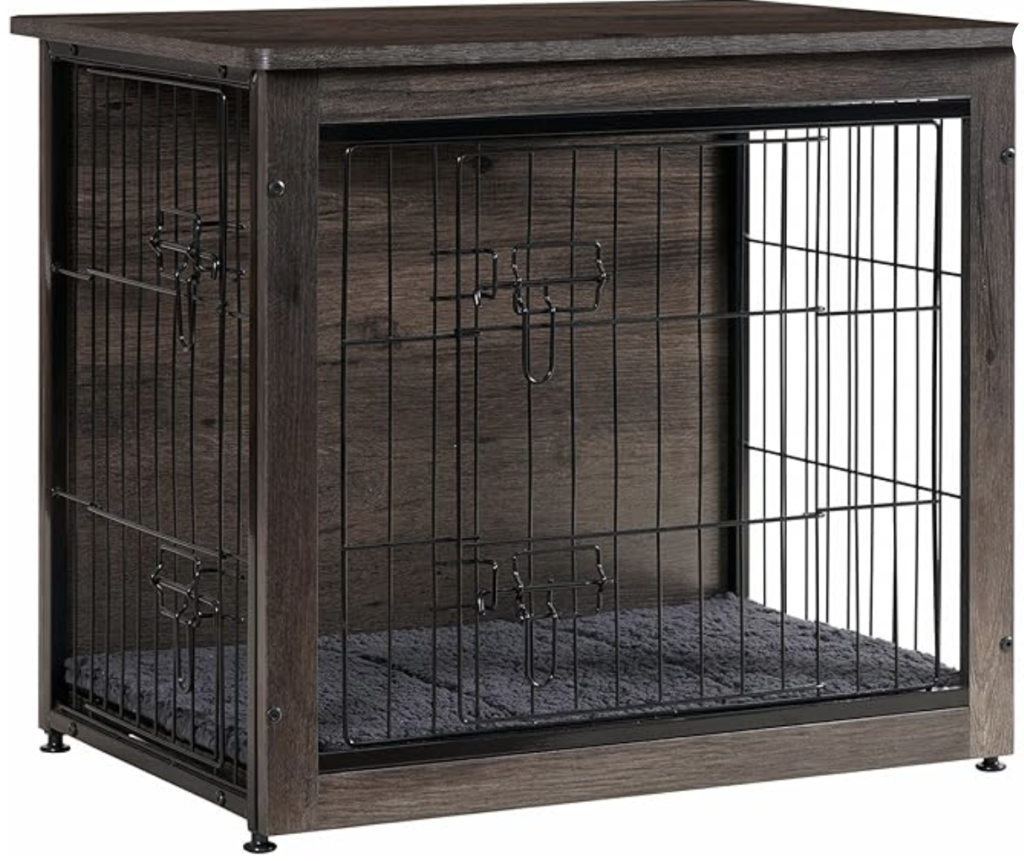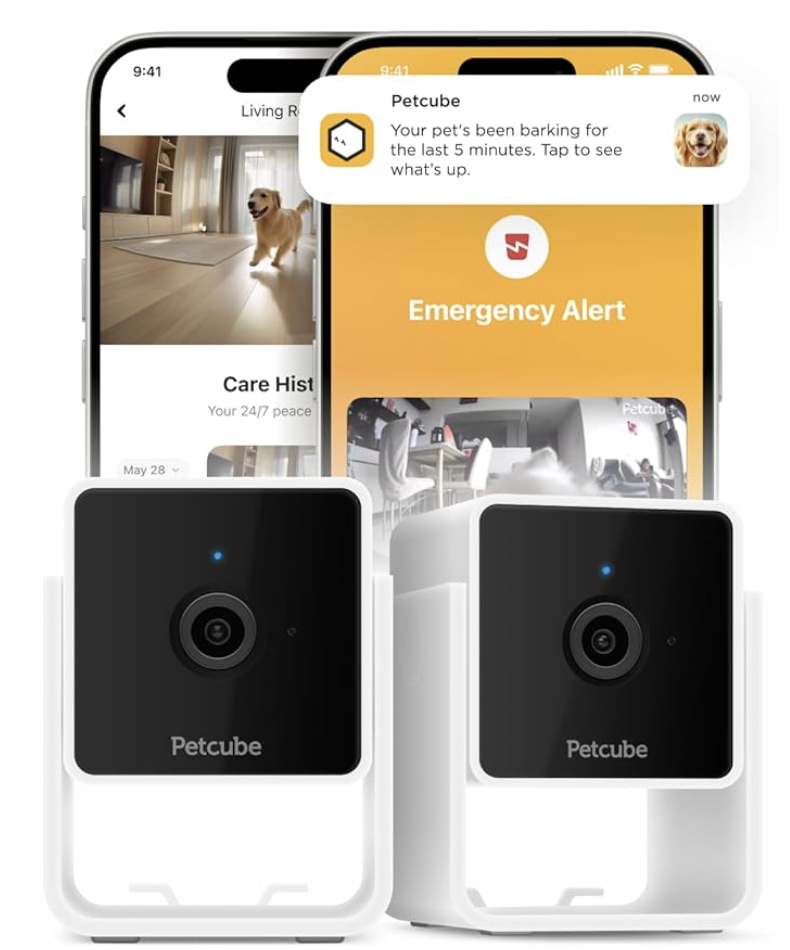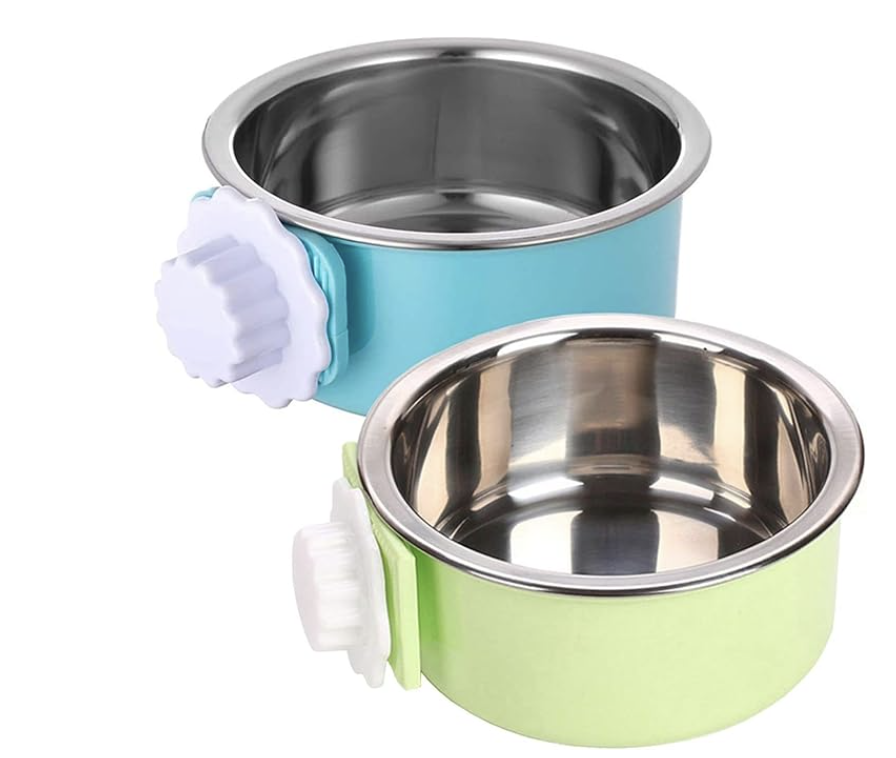Disclosure: Some articles on this site may contain affiliate links, meaning, at non additional cost to you, Chicago Urban Pets may earn a commission if you click through and make a purchase. As an Amazon Associate we earn from qualifying purchases.
As some of you may know, my whole business was built around caring for dogs while their parents were at work. That often meant giving them a break from the crate and some love while home alone.
But when I brought home my own Yorkie puppy, Roxy, in late summer of 2024, I was surprised by how guilty I felt leaving him crated for anything longer than a quick nap. I knew the facts, but it still felt different when it was my own dog.
So here I am, sharing what’s generally considered to be optimal crate time, while also recognizing that every dog and every family is different. Feeling guilty about crating your dog is completely normal, but it doesn’t mean you’re doing something wrong. The most important thing is to stay in tune with your dog’s needs. If you start noticing signs of stress or boredom, it might be time to consider hiring a dog walker or creating a setup at home that gives your pup a little more room to move around when you’re away for long hours.
If you are looking for a reliable and vetted dog walking company in Chicago, IL, I highly recommend Green Paws Chicago, whom I entrusted my client base when closing our pet care services.
Summary
- Crating during work hours can be helpful if your dog is crate trained and has a dog walker to let them out during that time.
- It’s not ideal for extended periods and can lead to dog anxiety and unwanted behaviors.
- Considering setting up a play pen, or closing off a portion of your home as an alternative to crating when at work.
Am I doing the right thing by crating my dog during work hours?
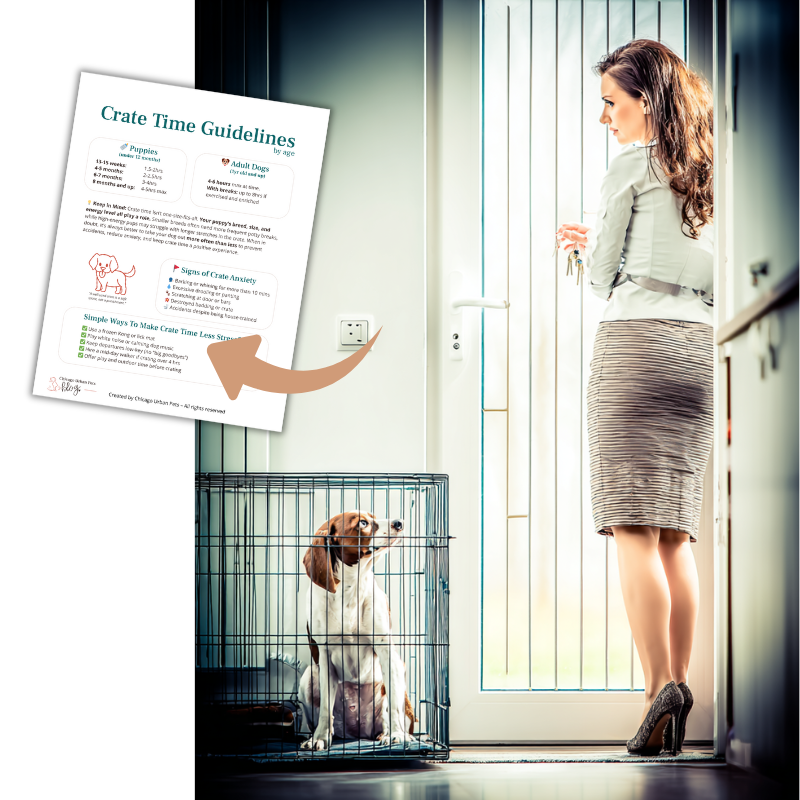
- ? A quick-glance chart with crate time limits by age
- ✅ Best practices for safe, healthy crating
- ? What to avoid to prevent anxiety, boredom, or accidents
When Crating is a Good Option

Many pet owners find that crating their dogs during work hours offers a sense of security and structure. When used appropriately, crates can provide a safe and comfortable space for dogs, helping to prevent unwanted behaviors and support training efforts (code for keeping that new couch of yours from being shredded to pieces).
Below are a handful of reasons why our family chose to incorporate a crate into our dog’s lifestyle:
Crates Can Provide Safety and Comfort
For many dogs, crates can be a cozy and safe space. They mimic a den-like environment, which can help anxious pups feel more secure when you’re not home. When introduced the right way, a crate can become a retreat your dog actually enjoys. For example, when the cleaning lady is here vacuuming, our pup Roxy will go lie in his open door crate to feel safer.
To help your pup feel comfortable in their crate, keep the door open when you’re home so they can explore it on their own terms. Add a soft crate bed and a blanket they like. To make it even more enticing, you can add treats in there. When Roxy came to us, we were given a little blanket that had his mama’s scent on it. We placed it in the crate, and it helped give him a sense of comfort and familiarity while he adjusted to his new space.
We just use a simple wire crate. (<- Amazon Link)
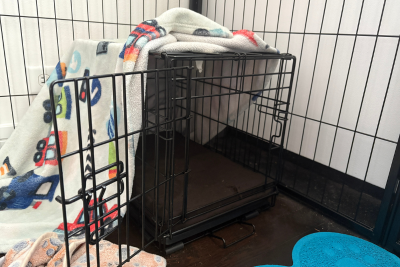
Crate Training Helps Prevent Destructive Behavior
If your dog tends to get into mischief while you’re away, crating can be a lifesaver. It can help prevent chewed-up furniture, missing socks, or even more serious situations. This is especially helpful for puppies and younger dogs who are still learning the rules of the house.
I once had a dog-walking client whose pup had a habit of chewing on cables. You can imagine how dangerous that could be if he had free roam of the apartment while no one was home. Ouch is right!
Kelly, owner of RK9 training, is a dear friend of mine and trainer =>check out RK9 Training’s awesome reel on crate training!<=
Crates Support Housebreaking
Housebreaking is just another word for potty training. Basically, it’s teaching our dogs that peeing and pooping happen outside only, not on the living room floor, and especially not on our $200 carpet. Crates can be a big help with this because most dogs naturally avoid going where they sleep, so a crate encourages them to hold it until they’re let out.
When used as part of a consistent routine, a crate helps your dog get into a rhythm. Most pups need to go pee right after a nap, so that’s a great time to take them out.
This blog post on potty training small dog breeds is a fave among our readers
Using the crate for short stretches while your dog is still learning the potty routine can really help. It not only supports the training process but also gets your pup comfortable with the crate little by little. That way, when the time comes to leave them for longer periods during the workday, the transition feels much easier.
When Crating May Not Be the Best Option
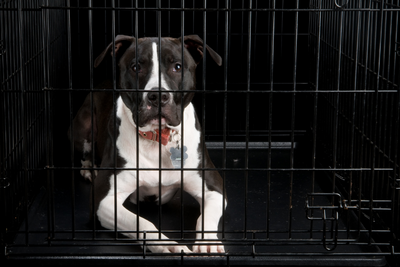
While crating has its benefits, it’s not the right fit for every dog or every situation. It’s important to pay attention to when crating might be causing stress or leading to behavioral issues, because your dog’s well-being should always come first.
A lot of pet parents who are struggling with behaviors they don’t quite understand end up learning (often with the help of a trainer) that their dog simply isn’t getting enough enrichment or exercise. And more often than not, that’s because the dog is spending long stretches of the day alone in the crate.
This is why it’s so important to watch out for the signs of an unhappy pup. Even if it feels inconvenient, adjusting your dog’s routine so they get more attention, movement, and mental stimulation can make a big difference. And yes, that might mean spending a little on a dog walking service (cough cough).

If you’re based in Chicago, we recommend Green Paws Chicago for compassionate, professional dog walking. They’re a trusted local service that helps your dog stay active and social even while you’re away.
(When signing up, don’t forget to mention Chicago Urban Pets to support the blog and help us continue creating helpful content.)
With our dog Roxy, I’ve noticed a pretty steady rhythm where he craves connection and enrichment in the morning and again in the evening. The rest of the time, he’s happy to lounge and nap. For us, that means I’d feel comfortable leaving him in the playpen alone during the day if we’re out, as long as he gets plenty of playtime and sniffing outdoors first thing in the morning and again when we’re home in the evening.
Note that I said playpen and not crate. I like him to have a bit more room to move around when he’s home alone. Of course, there are times when a crate is necessary, such as at the groomer’s or the vet. I think when it’s only now and then, it feels very different than using one every day.
Long Hours Can Lead to Stress or Anxiety
Crating for too long can cause frustration and restlessness. Just imagine, how would you cope locked in a small room where you can barely move for most of the day? right? Dogs are social beings and active creatures — spending 8+ hours in a confined space without interaction can and will inevitably affect their mental health.
That is why we set up a playpen for our Yorkie Roxy. This offers an alternative to keeping your dog contained and your baseboards safe while offering more breathing room for your dog. If you have a larger dog, I highly recommend closing off a portion of your home, making it pet safe, and letting that be where they can roam while you are at work or at brunch with friends.
If you are leaving your pup home alone, whether its in a crate, a playpen or closing off an area of your home, it can be worth investing in a petcam. I know it can feel a little pricy at first, but you won’t regret being able to check in on what they are doing, and this one here even lets you speak to your pup through the device!
Here is our set up:
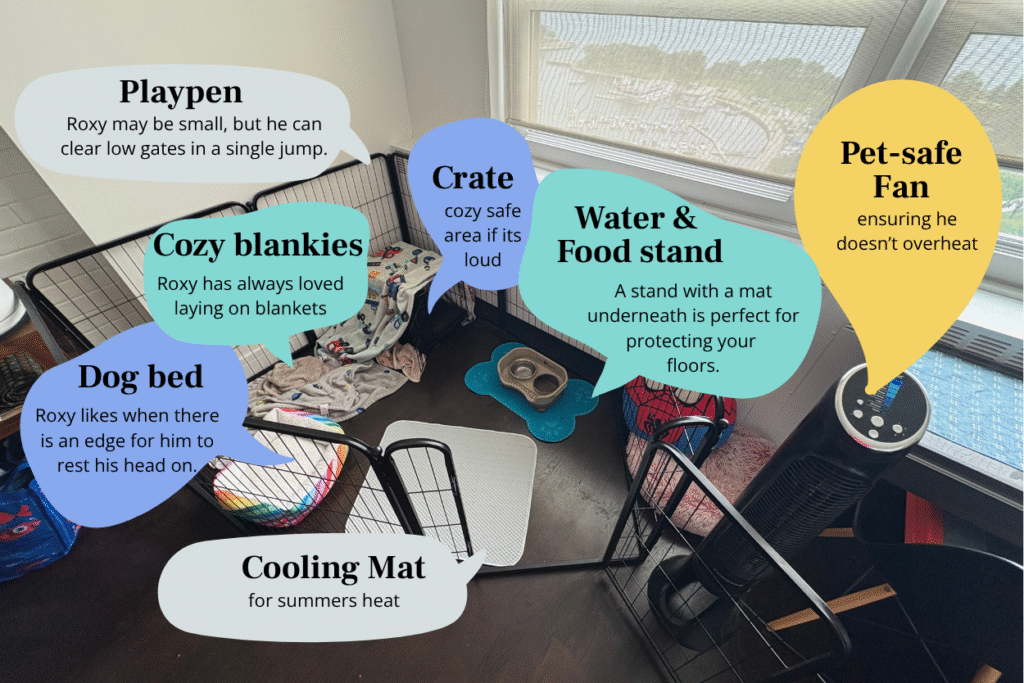
Want the list of products we used for our play pen and crate setup? Drop your email and I’ll send it over. You’ll also join my list where I share more tips and ideas to make life with your pup easier.
Don’t Forget their Need for Exercise and Enrichment
Even if your dog tolerates the crate well, they still need regular exercise, mental stimulation, and human interaction. Ensuring fewer hours of crate time alone can’t meet all of a dog’s needs.
As mentioned above, identifying your dog’s natural energy flow can help understand best times to engage in enrichment and exercise.
Don’t know what that might look like? Here are 5 ideas for you:
- During walks, give your pup time to sniff wherever they want for 5-10minutes
- Engage in the type of play your dog loves, that might be catch, tug of war or maybe simply your attention while petting them on their favorite spot on the couch.
- Play with some simple training, like Sit, Stay, Touch. Roxy loves playing hide and seek with me. My son holds on to him while I hide, then Roxy comes looking for me. He gets so into it!
Struggling to balance your dog’s needs while you’re at work? Check out Dog Sitter Rates in 2025 to explore cost-friendly care alternatives that keep your pup happy and safe during the day.

ps. I am a BIG fan of dog trainer Kelly Weekly (RK9 Training). She is the only person I had train my dog, Roxy, when he was a puppy. If you live in Chicago, definitely check her out!
How Long Is Too Long to Crate a Dog?
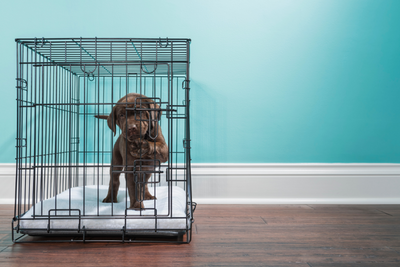
There’s no one-size-fits-all answer, but there are some helpful guidelines based on your dog’s age and your schedule. Understanding your dog’s needs will help you decide whether your routine is working or needs a few adjustments.
Below are a few things to consider when crating your dog:
- General Guidelines for Adult Dogs: Most adult dogs can handle being crated for about 4–6 hours during the day.
- Special Considerations for Puppies: Puppies need much more frequent breaks (every 2–3 hours) and may require a puppy pad setup with a playpen if you leaving them at home for work.
- What to Do If You Work Long Hours: If you work long hours, consider alternatives like a dog walker, pet sitter, or doggy daycare to break up your dog’s day and meet their physical and emotional needs.

If you’re based in Chicago, we recommend Green Paws Chicago for compassionate, professional dog walking. They’re a trusted local service that helps your dog stay active and social even while you’re away.
(When signing up, don’t forget to mention Chicago Urban Pets to support the blog and help us continue creating helpful content.)
Tips to Make Crating More Comfortable While You’re at Work

If you decide to crate your dog while you’re gone, setting them up for success is key. These tips can help create a more comfortable and enriching experience for your dog.
Choose the Right Crate Type and Size
The crate should be large enough for your dog to stand, turn around, and lie down comfortably. Some dogs prefer wire crates for airflow, while others feel more secure in plastic ones. Observe what makes your dog feel safest.
Add Safe Enrichment (Without Overstimulating)
A durable chew toy, a frozen treat toy, or a safe plush can help pass the time and ease boredom. Avoid anything that could pose a choking hazard or can be destroyed unsupervised.
Consider a Midday Break Option
If your schedule keeps you out of the house for 6+ hours, consider hiring a dog walker, asking a neighbor for help, or looking into doggy daycare a few times per week.
Check out these tips on finding the right dog walker for you and your pup.
Frequently Asked Questions About Daytime Crating
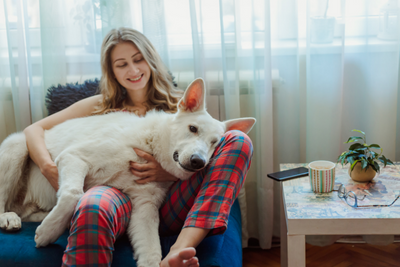
We’ve covered the basics, but here are a few common questions from pet parents about crating while at work:
1. Is it cruel to crate a dog while I’m at work? Not necessarily. Crating can be a helpful safety tool if done right. It is preferable though to set up a play pen or close off a portion of the home so your dog has more space to move around if they are home alone every day while you are at work.
2. How many hours is too long to crate a dog? Most adult dogs do okay with 4–6 hours of crate time, but doing so every day can affect their mental health. Puppies need more frequent potty breaks and should only be crated for 2–3 hours max during the day.
3. Should I leave water in the crate? You can leave a spill-proof bowl if your dog is crated for longer than a few hours. Just be cautious with young puppies who have a smaller bladders.
4. What are alternatives to crating while I’m at work? Dog-proofing rooms, play pens, or bringing your dog to doggy day care are all good options. The best choice depends on your dog’s personality and your daily routine.
You Might Also Be Interested In:



